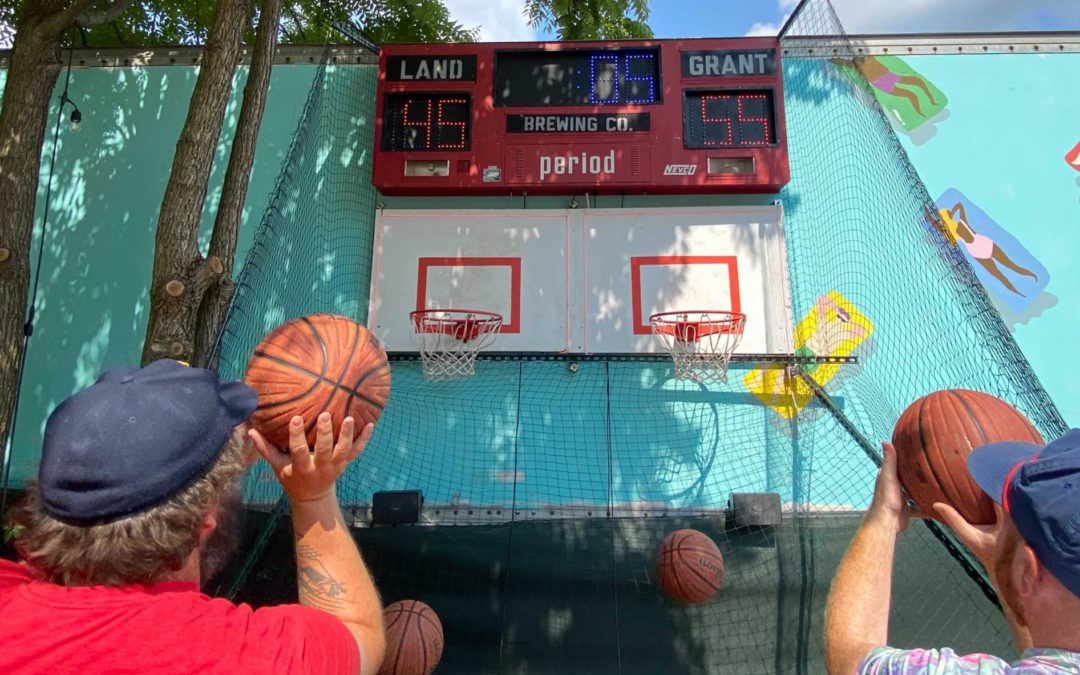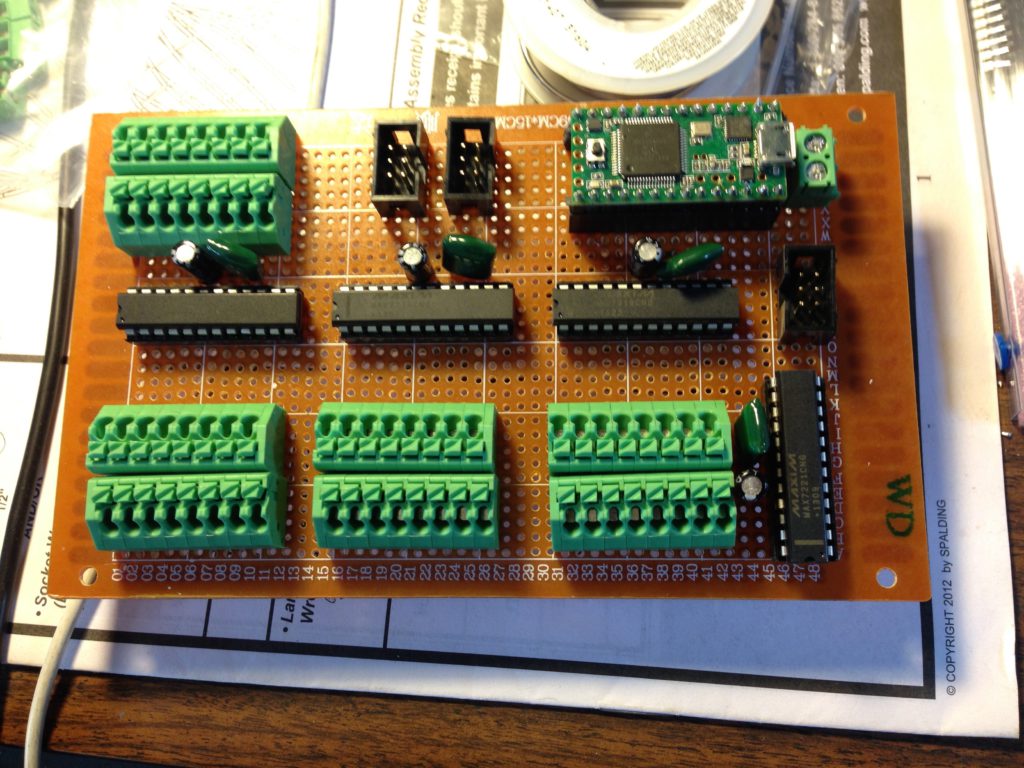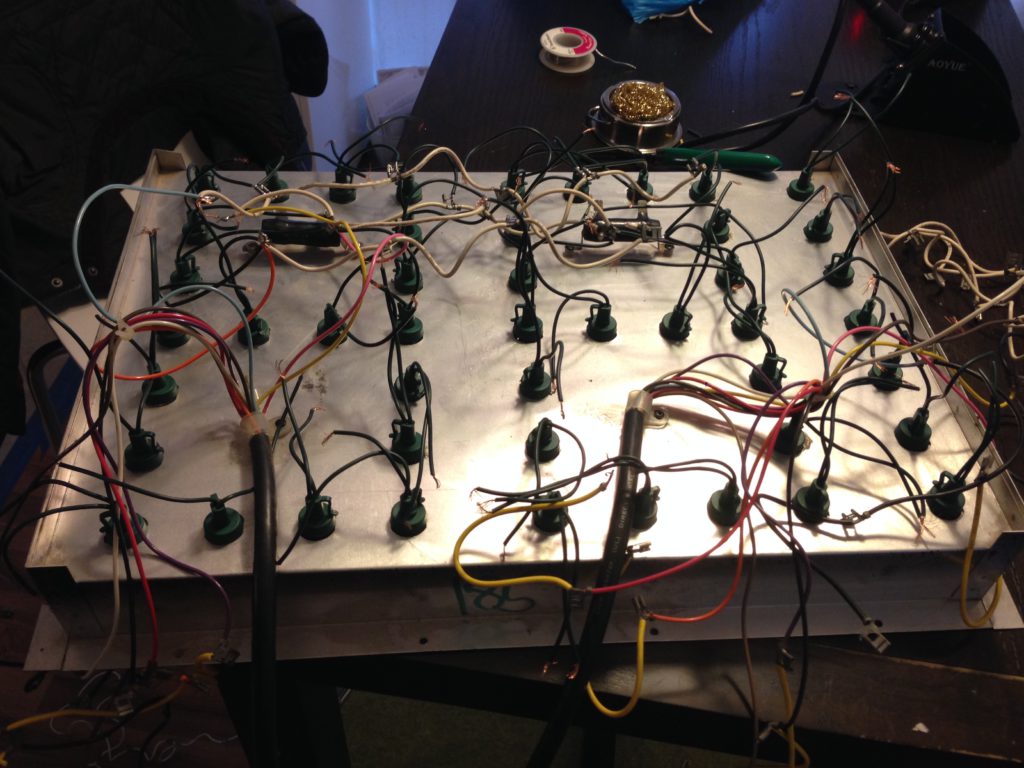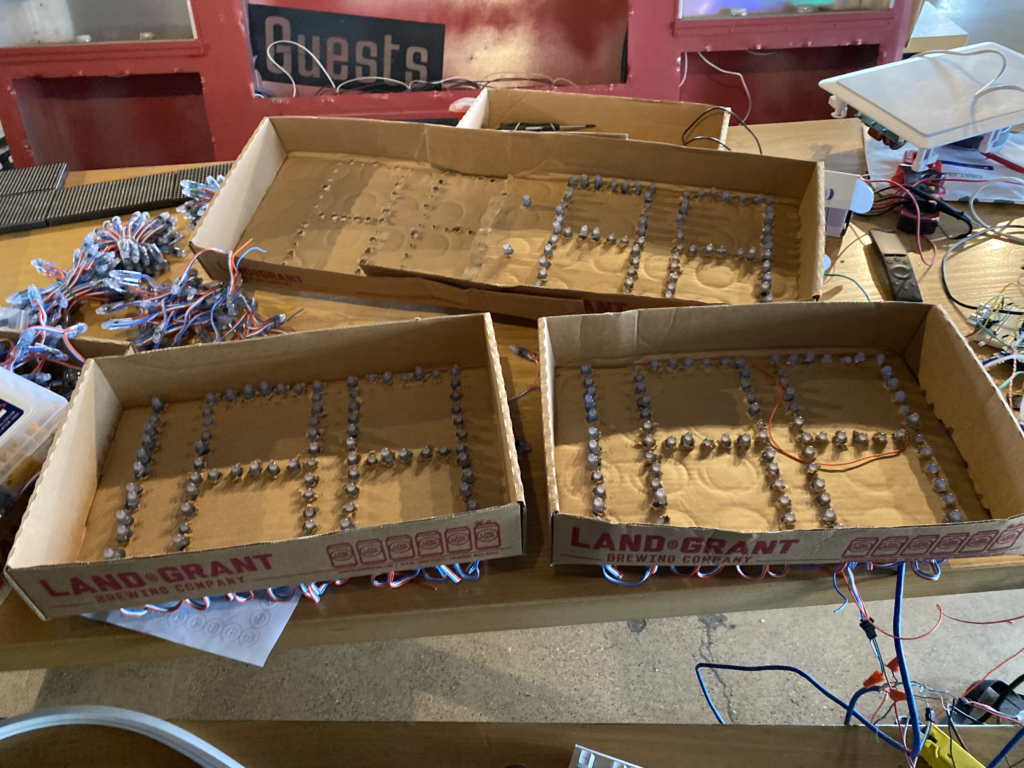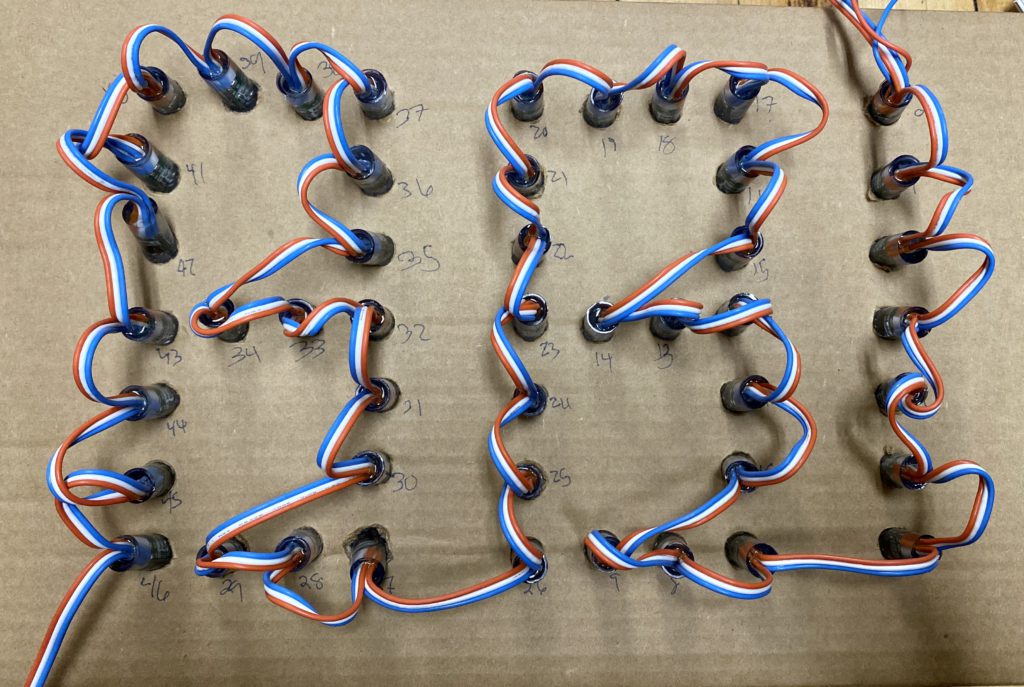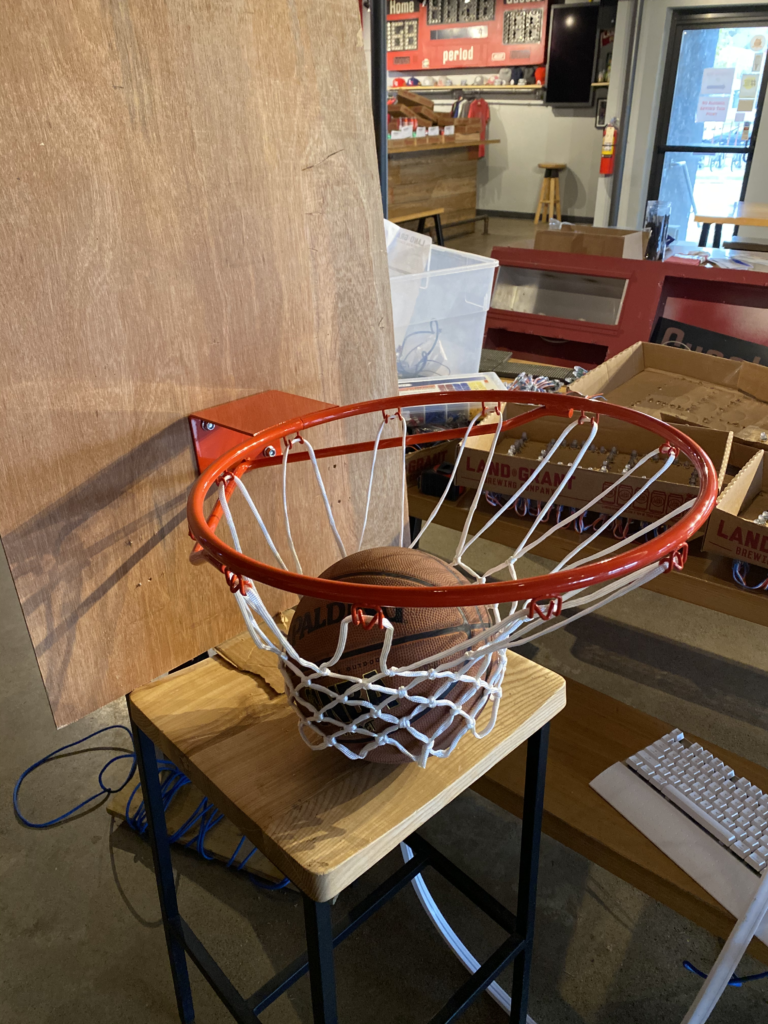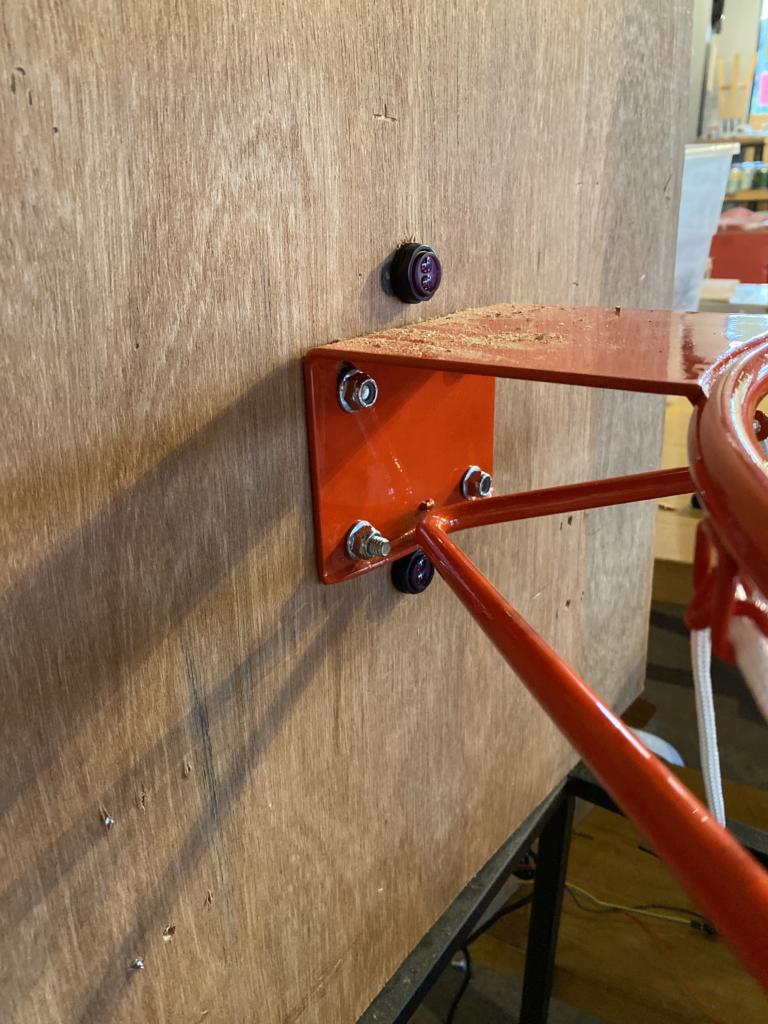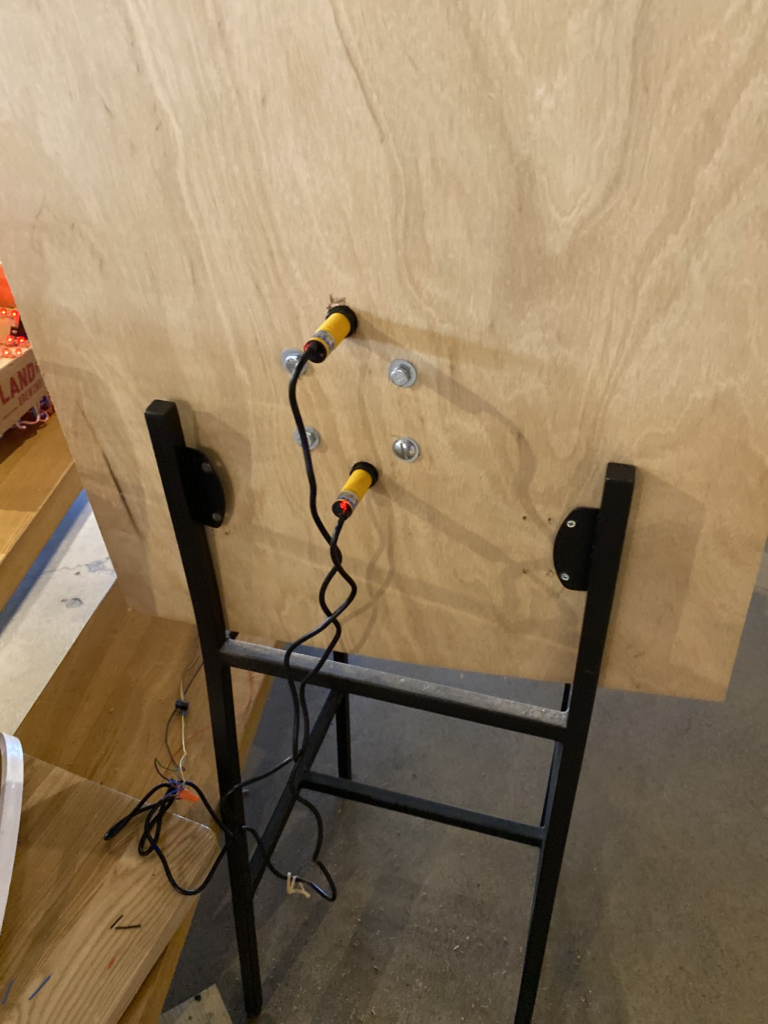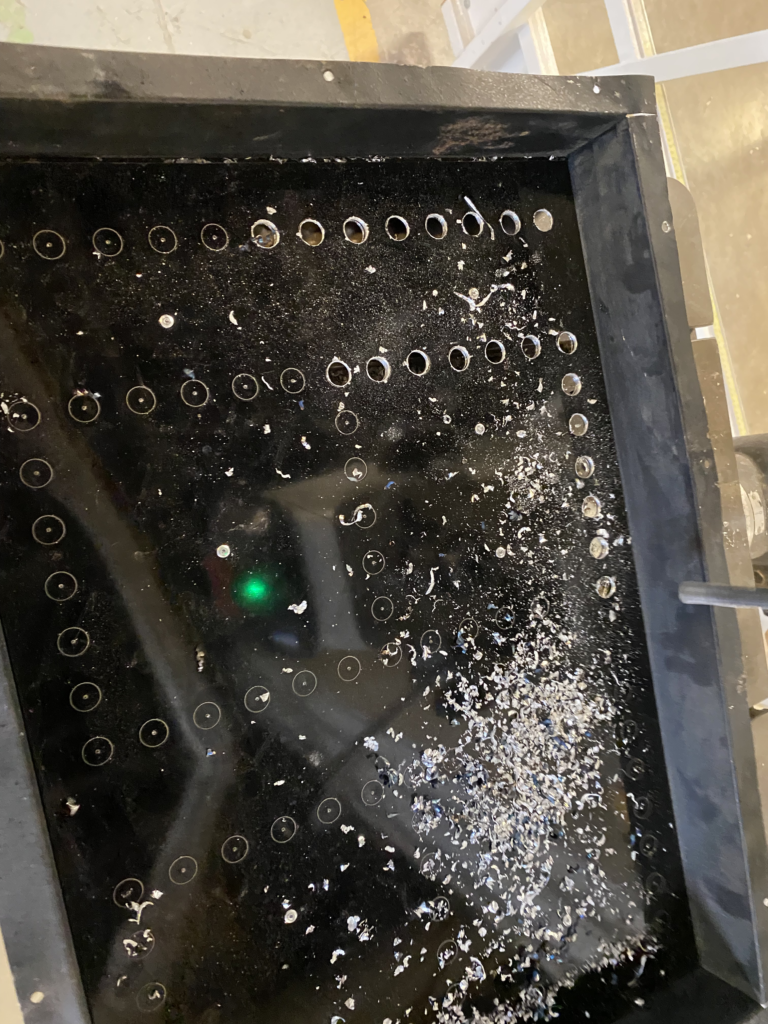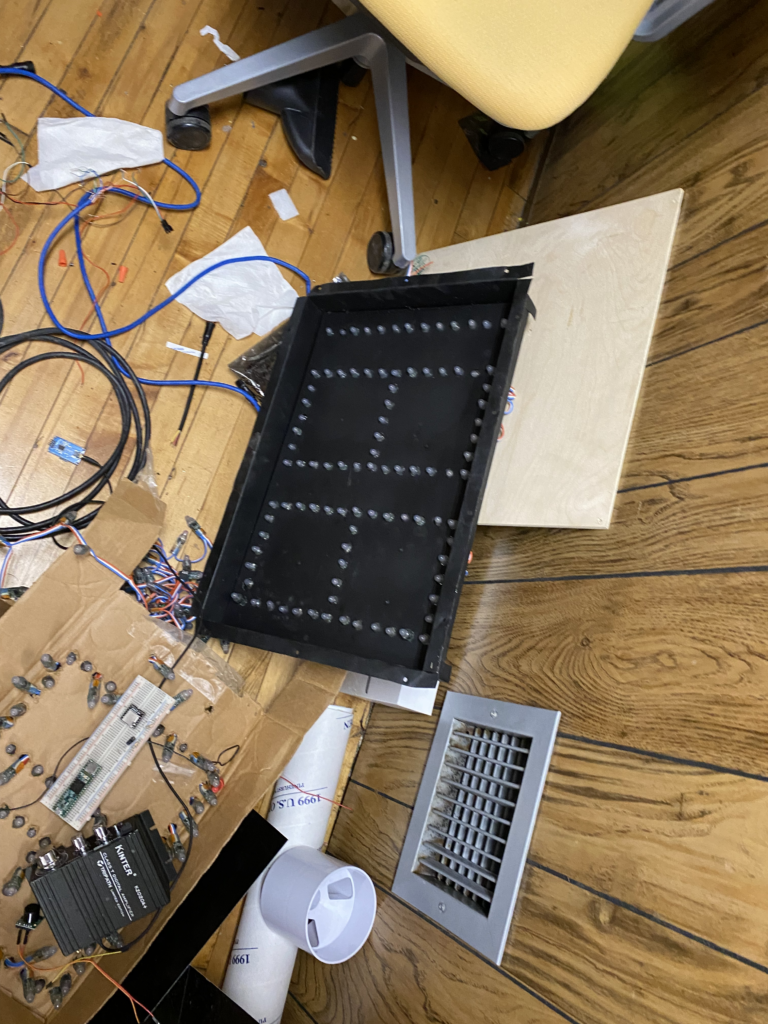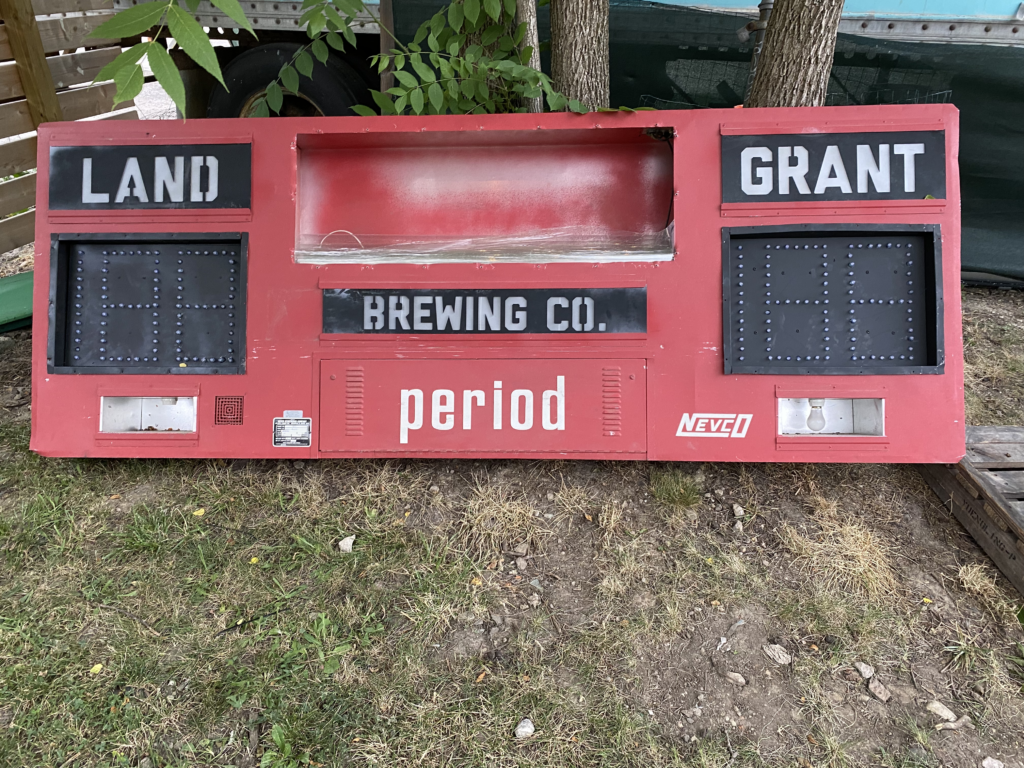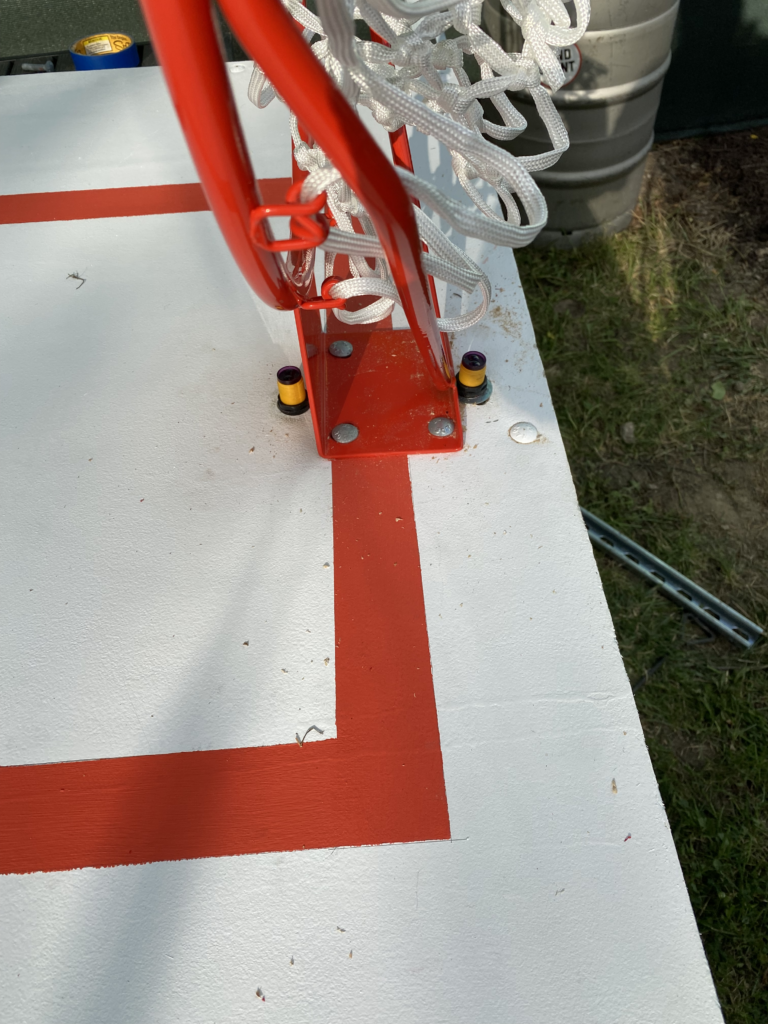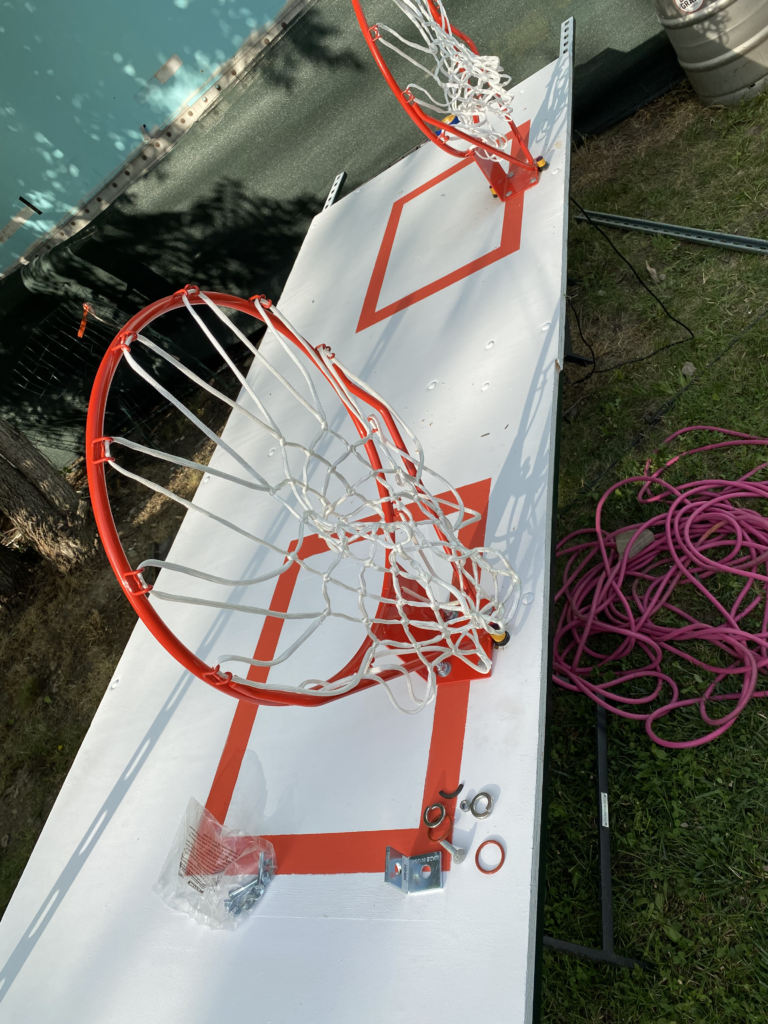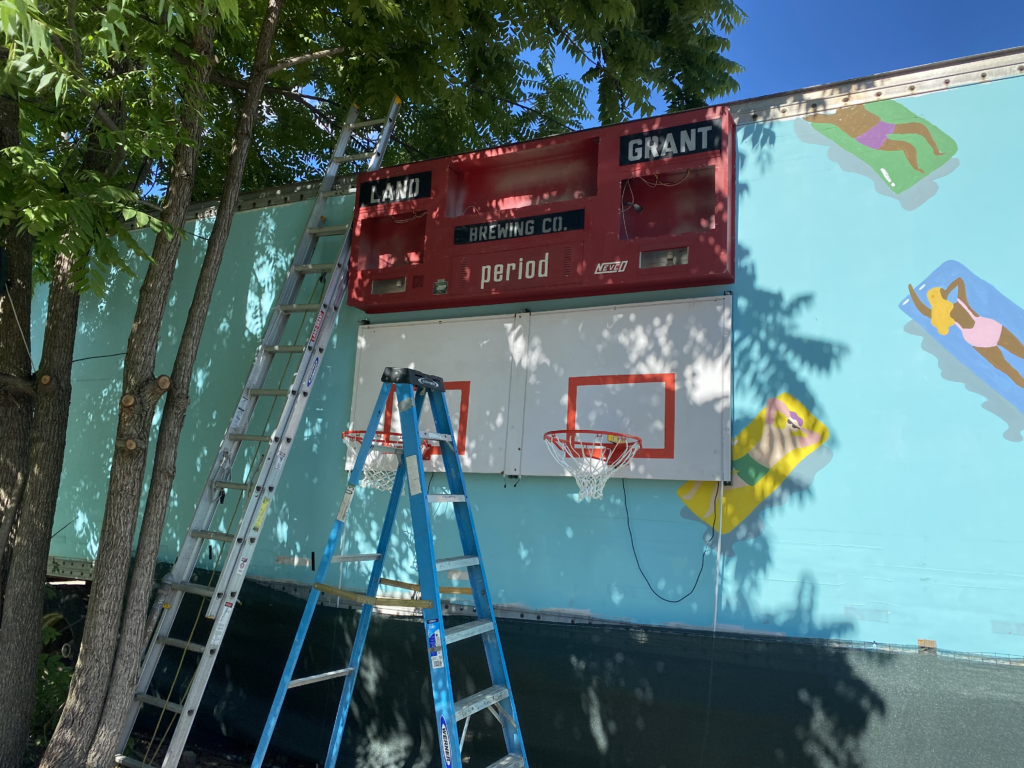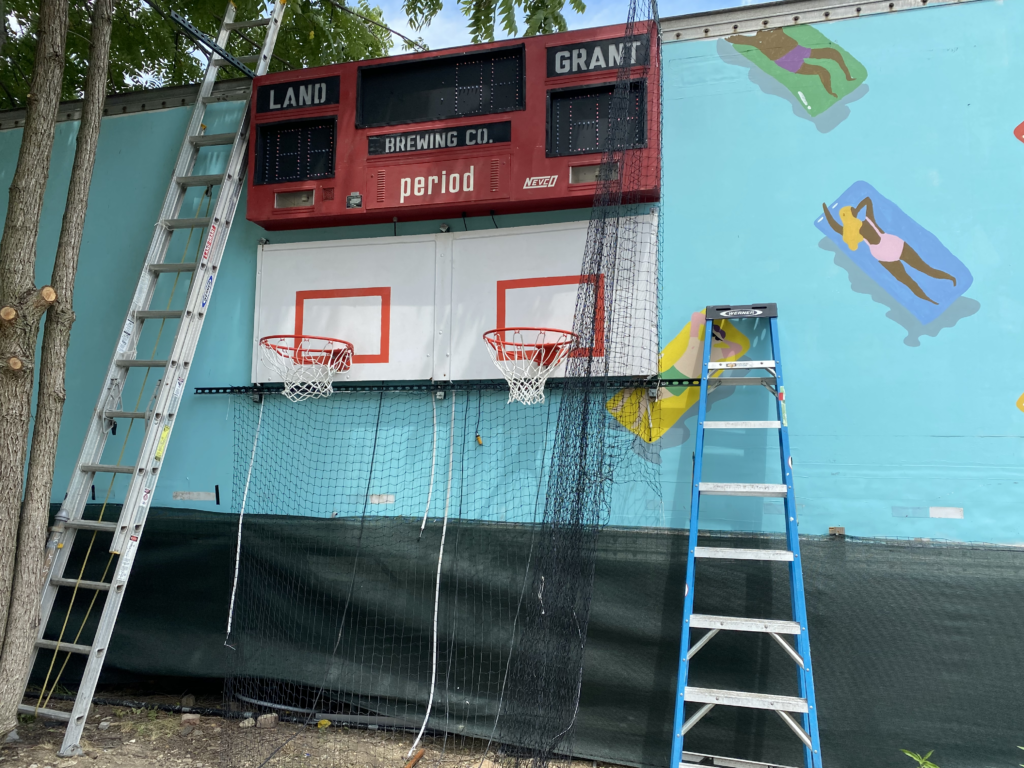Tip-Off
Walt and I had many ideas of things we thought would be “cool” to have at the taproom before opening Land-Grant. We drew inspiration from all over, but one place we kept going back to – which shared the aesthetic we wanted for our taproom – was “Spirit of 77” in Portland, OR. One of the features at Spirit of 77 is a homemade arcade-style basketball game, built from recycled materials from the Portland Recreation Club.

Growing up, we had an arcade-style basketball game in our house. My sister and I would spend hours playing against each other competing for the high score. When our cousins would come over, we would team up and stay up all night to see how far we could go shooting at one basket (and if my memory serves me correctly, it was somewhere around 210 points!) That game even had a short life in the foyer of Walt and my college house on E 14th at Ohio State, the remnants of which were turned into a basketball hoop in the living room of our senior year house on E. 17th.
Fast forward to 2013, the year I discovered the wonderful world of auctions. I had been an eBay member since 1998, but never had participated in an in-person auctions before. Because the budget was very tight when we were starting the brewery, auctions became a great way to get things we needed (like bar and brewery equipment)…and also exposed us to things we probably didn’t need (like basketball hoops, ping pong tables, etc) – all at a great price. I came across an auction for the Elgin School District, just south of Marion, OH, that was closing a Junior High and Elementary school and among the items available were two gymnasium scoreboards that looked to be in good condition.

Our plan was to get one scoreboard to decorate the taproom. Walt was the only bidder, so they offered him the second at a great price. To our surprise, both were in working condition. In the first couple of years of the taproom, we used the scoreboard to display the Ohio State football scores during the game, and would leave the Michigan score up for the year. The only drawback was the scoreboard used old incandescent light bulbs, so it used a lot of electricity and sitting next to it generated a lot of heat . We did switch out the bulbs for LEDs, but the old circuits did not last long with the newer technology and the scoreboard reverted to a decoration.

Once I knew we had an extra scoreboard, my wheels started turning and I thought back to the arcade-style basketball game at Spirit of 77. In my spare time when I wasn’t home brewing, I had been tinkering around with microcontrollers and Raspberry Pi computers. I built our first keg washer at the brewery to leverage automated valves controlled by a Raspberry Pi program. The machine worked well, though because I did not know how to weld stainless steel, it did not last in the harsh production environment. However, I did feel strongly that I could apply this knowledge to build the electronics needed to create our own arcade basketball game using the additional scoreboard.
As an escape from the long days of planning the brewery’s opening, I would tinker with the layout and programming of the system. I came across an Arduino compatible microcontroller, the Teensy that had the computing power to handle what I was trying to accomplish. I found examples of LED matrixes that I could use to layout the numbers, timing programs for the timer, and sensing circuits to count the score.
At the time, the only way to create the LED matrix was to use a specific chip that allowed you to send an on/off signal to an individual LED. The problem was that each LED needed to be wired back to the chip, so it was a pretty tedious task. I built my control board and wired one of the scoreboard number panels as a prototype.
I was using LED Christmas lights, which were a pretty new thing back in 2013. I also was able to reuse some of the original wiring, as the old electronics also needed to have every bulb wired back to the original controller. I wrote a test program that could change the numbers based on input from my computer.
While it all worked, there was a lot more work that needed to be done – everything from wiring all of the lights to figuring out how I was going to record shots that were made. Much of this work was happening while we were putting the finishing touches on the brewery, and ultimately – I needed to shift all my attention to getting the brewery opened and operational. This arcade-style basketball game project was shelved and we did not end up having anywhere to put the game inside since seating became a higher priority given the great response we received from the Columbus community upon opening. (A good problem to have, of course.)

Halftime
I had not thought about the arcade-style basketball game project for quite a while, but then – like many other folks – I found myself in need of a stimulating project once we knew the pandemic was in full force and the taproom and most of production had been halted. As we shifted to carryout only, we took the opportunity to rethink our merchandise display in the brewery. Tony, the member of our team who leads our merch efforts, had asked me if we could take it the non-functional scoreboard to create a proper merchandise display. While I was reluctant, I finally gave in knowing he would be able to create a great display with more real estate. With the removal of the scoreboard all these years later, it sparked the memory of the abandoned project. Thankfully, the difference at this time was that we now had a 10,000 square foot Beer Garden that has dedicated space for games and activities.

Over the past few years I still tinkered with LEDs and microcontrollers, creating signage for a stand at MAPFRE Stadium, our taproom, and a model of the taproom. I discovered that there were new LEDs that were wired in a strand, but had built-in chips that allowed a microcontroller to individually address a single LED. This was a breakthrough, as it would make the electronic circuit and programming simpler and more streamlined. I ordered some strands from Amazon and started building my new prototype. While we waited for orders to come through the website, I tinkered away putting LEDs in our cardboard case trays to lay out the numbers for the scoreboard.
To create a program for the lights, I followed some guides I found online and mapped out the individual LEDs to number patterns. It was a lot easier than the original set up, and I was able to get it working within a couple weeks. Once I had the numbers figured out, the next step was how to count the baskets people made.
Our original arcade-style basketball game had a lever that would count a bucket when engaged, though this feature is what did ours in – as it was not designed for the abuse from college kids. I found that a lot of older arcade systems used a ring around the bottom of the net with a switch that would count baskets, and newer games used sensors to detect the ball. I decided to order and test out a bunch of different sensors and found that the retroreflective photoelectric sensors were what worked best. These have both a transmitter and receiver built in to send an infrared beam that will bounce back to the receiver when an object is close.

I wanted to do my best to avoid false readings that if the sensor was below the hoop it may count airballs, if it was above the hoop it may count shots that bounce off the rim. In order to prevent this, I put a sensor above and below the rim. This would only count a basket if the ball tripped both sensors at the same time as it was passing through the hoop. I tested this out and the whole system worked. The next step was building a basket to make sure the application worked overall. I took a broken bar stool, screwed some plywood to the back, affixed the rim and two sensors. I had a working prototype!
It was at approximately this point where the project got put on hold for a second time. We found out that some restrictions were getting lifted on outdoor bars and restaurants, which meant the Beer Garden could reopen. One of the reopening rules was that you must be seated while drinking, so games and open congregate areas weren’t allowed. So while we had the space for the game, there was no reason to set it up until more restrictions were lifted.
The Final Countdown
Fast forward to this summer when all restrictions were lifted on June 2. As soon as we had operations in a good place, my goal was to finally finish the arcade-style basketball game project. Luckily we have the Columbus Idea Foundry next door, so I was able to use the laser cutter, wood shop, and metal shop to put the finishing touches on taking the cardboard prototypes and build the final panels for the scoreboard.
I built the hoop, wired everything up, and we got it mounted to the side of the semi-trailer in the beer garden.
My dream of having our own arcade-style basketball game at the brewery finally happened! While we wanted to get it fully up and running for the first weekend, the scoring sensors were not working correctly and just kept counting up. As a result, the game debuted with just a timer. There was also a minor hiccup that first weekend when someone yanked a wire, then accidentally connected it to another wrong wire and fried the electronics. Thankfully, I was able to get new parts – including new sensors – to get the game fully up and running. It is worth noting that every now and then, you may still get some false readings – so don’t go making huge wagers against your friends.

I hope you enjoyed this story and that it gave you a glimpse into all the “little” things that we try to do at the brewery to make it a fun and inviting environment for everyone. You’ll probably find me out in the Beer Garden some nights trying to set a new record. Feel free to jump in, as I am always up for a challenge.
– Adam Benner, Land-Grant President & Co-Founder

